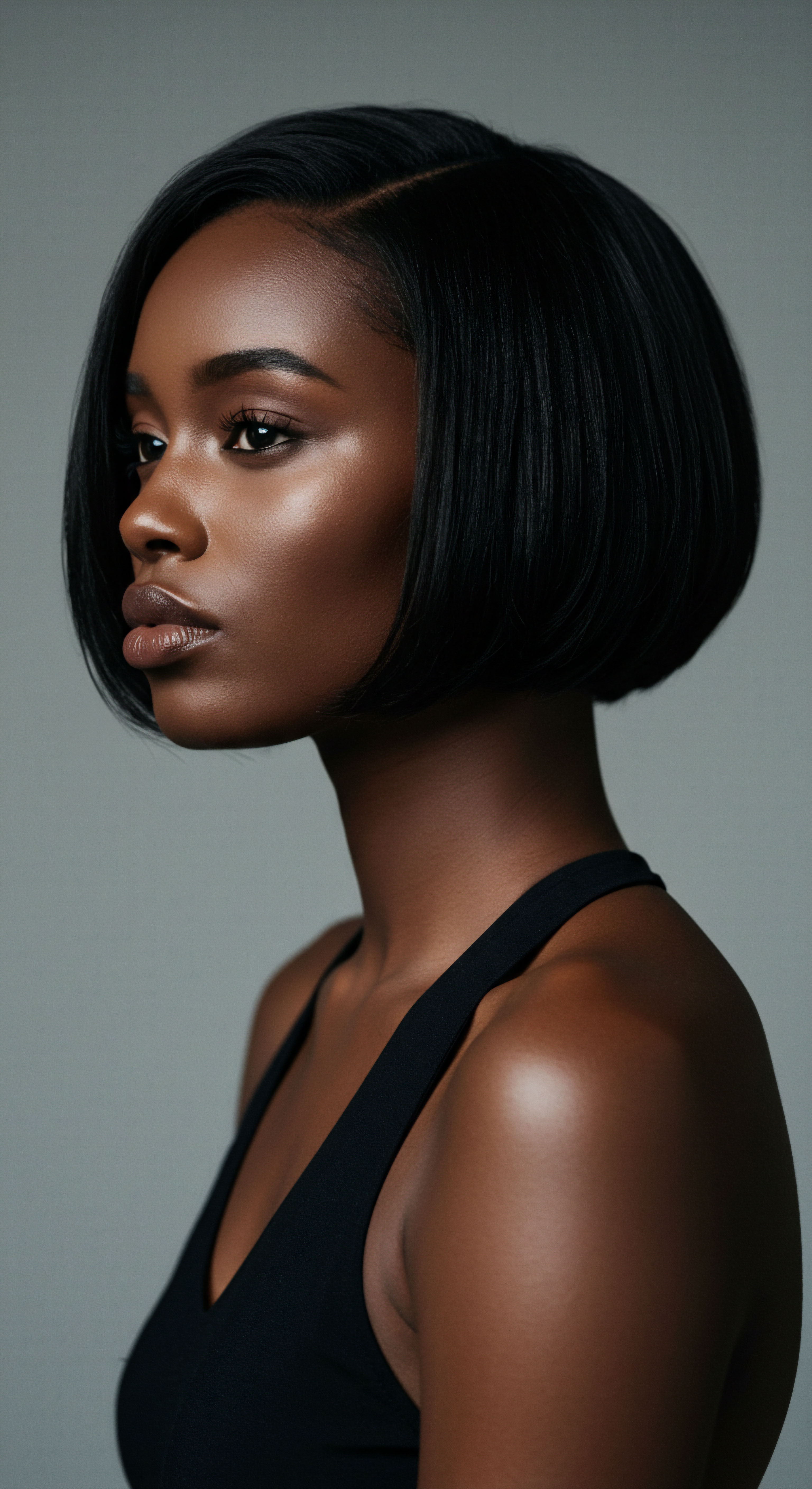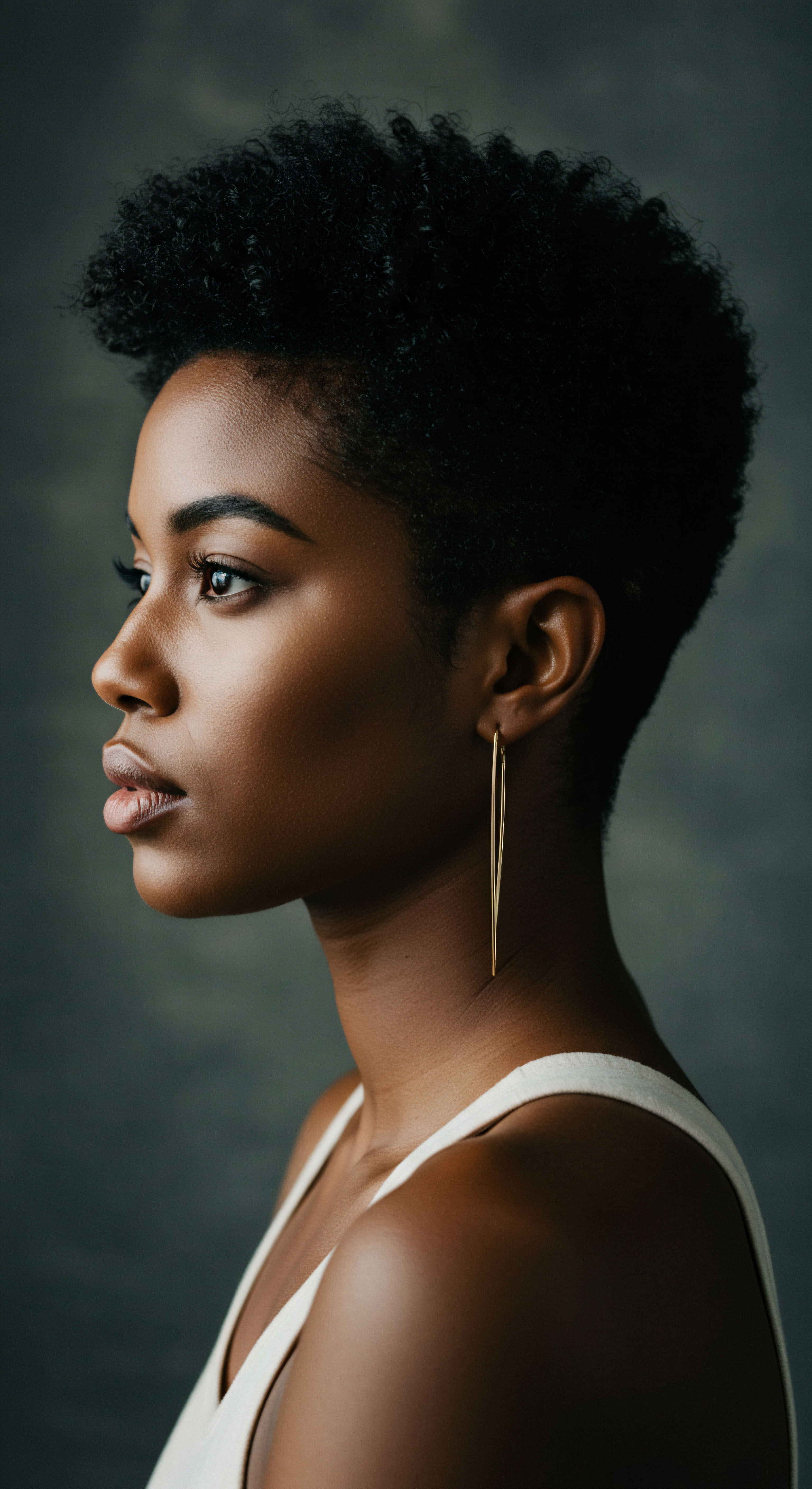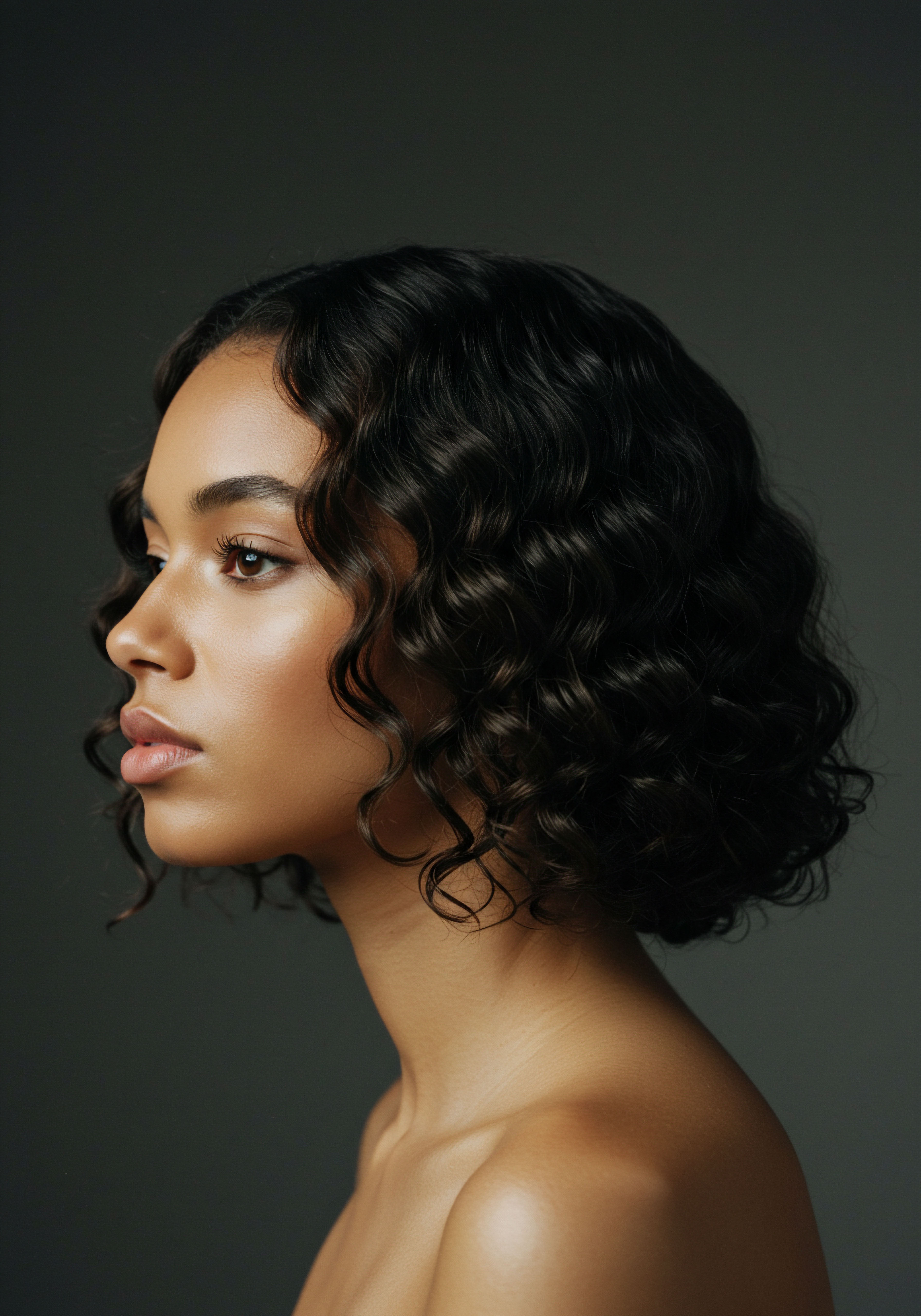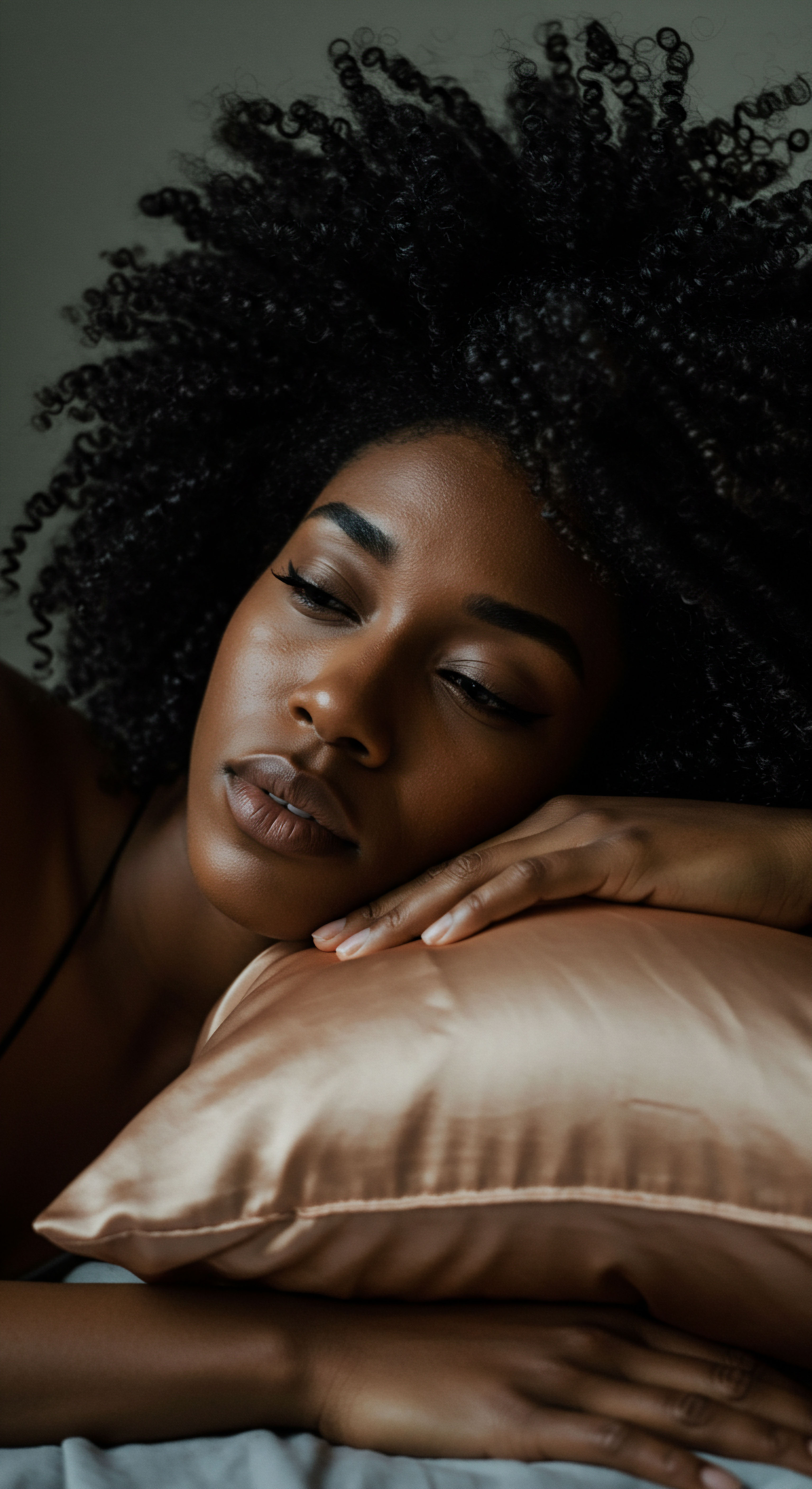
Fundamentals
The quiet hours of slumber, often envisioned as a time of complete repose for the body, hold a subtle yet significant dynamic for our hair, particularly for those with textured strands. This unseen interplay, a gentle yet persistent engagement between hair and surface as we shift and dream, finds its explanation in what we term Nocturnal Traction. It is a concept that invites us to consider the often-overlooked mechanical forces exerted upon our tresses during the night, a quiet dialogue between hair and its resting place.
Understanding the Nocturnal Traction begins with a recognition of its most straightforward definition ❉ the collective forces of friction, tension, and compression that act upon individual hair fibers and entire hair groupings while we sleep. Imagine the delicate ballet of movement as one turns, the subtle rub of hair against a pillowcase, or the gentle pull within a loosely gathered style. These are the elements that comprise this nightly phenomenon.
For individuals with Black hair, mixed-race hair, or any form of highly textured hair, this understanding carries a particular weight, given the inherent structural characteristics that render these hair types more susceptible to mechanical wear. The natural coils and kinks of textured hair create more points of contact and greater surface area for friction, making the nightly dance with bedding a more impactful event.
Nocturnal Traction describes the mechanical forces, such as friction and tension, exerted on hair during sleep, profoundly influencing the well-being of textured strands.

The Gentle Abrasion of Nightly Movement
At its core, Nocturnal Traction is about the mechanical stress hair endures when it interacts with bedding materials. The very act of repositioning during sleep, even imperceptibly, creates a rubbing action. This rubbing generates friction, a resistive force that can lead to the lifting of cuticle scales, those protective shingle-like layers that shield the inner cortex of the hair. When these scales are disturbed, hair becomes more vulnerable to moisture loss and subsequent breakage.
For coily and kinky hair patterns, the spiral structure means hair strands often intertwine and knot, amplifying the effects of friction. A single strand, caught in a tangle, might experience greater resistance against a fabric surface, increasing the likelihood of damage. This fundamental explanation of Nocturnal Traction lays the groundwork for appreciating why thoughtful nighttime hair rituals are not merely an indulgence, but a genuine act of care for maintaining the vitality of textured hair.
- Friction ❉ The resistive force created as hair glides or rubs against surfaces like pillowcases, leading to cuticle disruption.
- Tension ❉ The pulling force on hair strands, often occurring within protective styles that shift during sleep or when hair is caught beneath the body.
- Compression ❉ The squeezing force on hair, particularly when strands are pressed between the head and a pillow, which can distort the hair shaft.

Intermediate
Moving beyond the foundational concept, an intermediate understanding of Nocturnal Traction delves into its practical manifestations and the subtle ways it shapes the daily experience of textured hair. Here, the focus shifts from a mere recognition of forces to an appreciation of their cumulative impact and the methods employed to mitigate their influence. It invites a closer look at the rituals and tools that become companions in the nightly preservation of hair health.
The common contexts in which Nocturnal Traction exerts its presence are varied, yet interconnected. Consider the ubiquitous cotton pillowcase, a seemingly innocuous household item. Its fibers, though soft to the touch, possess a microscopic roughness that acts as a subtle abrasive against the delicate cuticle of textured hair.
As one shifts through the night, each movement becomes a miniature tug-of-war, gradually eroding the hair’s protective outer layer. This continuous, low-level stress contributes significantly to concerns like frizz, dryness, and visible breakage, often perplexing those who diligently maintain their hair during waking hours.

The Unseen Choreography of Nighttime Hair Care
Practical applications of understanding Nocturnal Traction often revolve around creating a gentler environment for hair during sleep. The transition from a standard cotton pillowcase to one crafted from silk or satin represents a pivotal shift in this regard. These smoother fabrics significantly reduce the coefficient of friction, allowing hair to glide rather than snag, thus minimizing the mechanical stress that leads to cuticle damage and tangling. The difference is palpable, often translating to noticeably softer, less matted hair upon waking.
Strategic material choices and styling methods during sleep are essential in minimizing the cumulative micro-damage textured hair experiences from Nocturnal Traction.
Furthermore, the adoption of specific nighttime hair care rituals forms a protective shield against these forces. Protective styles, such as braids, twists, or pineapple buns, are not merely aesthetic choices but serve a functional purpose in safeguarding hair from Nocturnal Traction. By containing the hair and reducing its direct contact with bedding, these styles minimize friction and prevent the formation of knots and tangles that are exacerbated by nightly movement.
| Strategy Silk/Satin Pillowcases |
| Mechanism of Protection Reduces friction coefficient, allowing hair to glide smoothly. |
| Strategy Hair Bonnets/Wraps |
| Mechanism of Protection Creates a barrier between hair and bedding, minimizing direct contact and absorption of moisture. |
| Strategy Protective Styles (Braids, Twists) |
| Mechanism of Protection Contains hair, reducing tangling and exposure to abrasive forces. |
| Strategy Moisturizing Hair Before Bed |
| Mechanism of Protection Enhances hair's elasticity, making it more resilient to mechanical stress. |

Beyond the Surface ❉ Moisture Dynamics and Nocturnal Traction
The practical understanding of Nocturnal Traction also extends to the intricate relationship between moisture balance and mechanical resilience. Hair that is adequately moisturized possesses greater elasticity and is less prone to breakage when subjected to physical forces. Conversely, dry hair, with its brittle structure, is more susceptible to damage from even subtle nightly friction.
The cotton pillowcase, beyond its abrasive qualities, also draws moisture from the hair, creating a dual challenge for maintaining hydration. This absorption further compromises the hair’s ability to withstand the continuous, subtle tugs and rubs of sleep, accelerating the process of mechanical degradation.
Therefore, integrating hydrating products into an evening routine becomes a quiet yet potent defense against Nocturnal Traction. A light application of a leave-in conditioner or a nourishing oil before gathering hair for the night helps to fortify the strands, rendering them more pliable and resistant to the micro-trauma inflicted by sleep. This holistic approach, combining environmental adjustments with internal hair fortification, exemplifies an intermediate understanding of how to effectively manage the ongoing influence of Nocturnal Traction on textured hair.

Advanced
At an advanced stratum of comprehension, Nocturnal Traction transcends a mere description of forces; it becomes a lens through which to examine the profound interplay of biomechanics, material science, and even the subtle, long-term psychological impact on those navigating the care of textured hair. This sophisticated interpretation demands a precise delineation of its full significance, moving beyond superficial remedies to address the root causes and cumulative effects within the unique architecture of Black and mixed-race hair. It is here that we discern the nuanced implications, often overlooked in more general discussions of hair health.
The scientific explanation of Nocturnal Traction’s influence on hair fiber mechanics is intricate. Textured hair, particularly highly coily and kinky patterns, exhibits a unique elliptical cross-section and an uneven distribution of cuticle scales along the hair shaft. This structural asymmetry, coupled with a naturally higher coefficient of friction compared to straight hair, renders it exceptionally vulnerable to mechanical abrasion. During sleep, the continuous, low-magnitude forces of friction and compression lead to a progressive lifting and eventual erosion of these protective cuticle layers.
This process exposes the delicate inner cortex, leading to increased porosity, accelerated moisture loss, and a significant reduction in tensile strength. The consequence is not merely superficial frizz, but a deeper structural compromise that manifests as chronic dryness, brittleness, and breakage that can seem disproportionate to perceived daily handling.
Nocturnal Traction, understood through a biomechanical lens, reveals how textured hair’s unique structure renders it disproportionately susceptible to cumulative micro-abrasion, impacting its long-term integrity.

The Microscopic Battle ❉ Cuticle Integrity and Nocturnal Stress
Consider the microscopic landscape of a single textured hair strand. Its helical twists and turns mean that specific points along the coil are constantly exposed to direct contact and friction with bedding surfaces. Unlike straight hair, which may slide more uniformly, the inherent bends in textured hair create localized stress points. Research into hair fiber mechanics, such as that detailed in the comprehensive work by Robbins, C.
R. (2012), Chemical and physical behavior of human hair (5th ed.), Springer Science & Business Media, highlights how repeated mechanical stress, even at low levels, can induce fatigue in the hair fiber. This fatigue can lead to irreversible structural changes, including the formation of micro-cracks along the cuticle and eventual fiber fracture. For textured hair, this process is exacerbated by its inherent structural fragility and often, by common care practices that may inadvertently contribute to dryness, further diminishing its resilience.
A less commonly discussed yet profoundly impactful aspect of Nocturnal Traction relates to the cumulative micro-trauma. While a single night’s sleep may not visibly damage hair, the repetition of these forces over months and years contributes significantly to overall hair degradation. For instance, studies examining the mechanical properties of African hair have shown that its tensile strength can be up to 50% lower than that of Asian hair when wet, and its elasticity differs significantly, making it more prone to fracture under tension.
This inherent mechanical vulnerability means that the subtle friction from sleeping on common fabrics like cotton, which might be negligible for other hair types, accumulates into substantial structural damage for textured hair over time. This continuous, unaddressed nocturnal stress can contribute to the persistent appearance of split ends, reduced length retention, and a perpetual struggle with dryness, even with diligent moisturizing routines.

Beyond the Strand ❉ Sociocultural and Psychological Dimensions
The complexities of Nocturnal Traction extend beyond the mere physical; they touch upon the very heritage and self-perception within the textured hair community. Historically, practices of head wrapping and intricate nighttime styling were not solely for aesthetic appeal but also served as practical measures to protect hair from environmental elements and, implicitly, from the rigors of sleep. These traditions, passed down through generations, speak to an ancestral understanding of hair’s vulnerability and the necessity of its preservation. The contemporary revival of silk bonnets and satin pillowcases is a modern echo of this ancient wisdom, bridging cultural practices with scientific understanding.
From a psychological standpoint, the ongoing battle with breakage and dryness, often unknowingly fueled by Nocturnal Traction, can lead to frustration and a sense of defeat for individuals striving to nurture their natural hair. The persistent perception that hair “isn’t growing” or “isn’t retaining moisture” can be disheartening, even when diligent care is applied during waking hours. Recognizing Nocturnal Traction as a significant, albeit subtle, contributor to these challenges offers a vital shift in perspective. It empowers individuals with the knowledge to implement targeted, effective strategies, transforming a source of vexation into an area of mindful care.
This deeper awareness fosters a more profound connection to one’s hair, acknowledging its delicate nature and the continuous vigilance required for its thriving. The long-term success of any hair care regimen for textured hair, particularly those aimed at length retention and overall vitality, hinges on a meticulous consideration of these often-unseen nocturnal forces.

Reflection
As we gently close our exploration of Nocturnal Traction, a quiet understanding settles, much like the hush of nightfall. This concept, initially perceived as a scientific explanation, transforms into a tender invitation ❉ an invitation to reconsider our nightly rituals, to infuse them with a deeper reverence for our hair’s inherent beauty and vulnerability. It is a quiet call to nurture, not just to manage, the coils and curls that crown us.
The journey through the intricacies of Nocturnal Traction reveals that the care of textured hair is not a linear path of product application, but a continuous dance between scientific insight and ancestral wisdom. It is about honoring the unique journey of each strand, acknowledging the silent forces that shape its destiny, even as we dream. In this recognition, we find not a burden, but a gentle empowerment, allowing us to cultivate a profound connection with our hair, celebrating its resilience and protecting its delicate splendor, one peaceful night at a time.

References
- Robbins, C. R. (2012). Chemical and physical behavior of human hair (5th ed.). Springer Science & Business Media.
- Porter, D. & Khumalo, N. P. (2012). The hair follicle ❉ An introduction to its biology and diseases. In N. P. Khumalo & D. Porter (Eds.), Hair and scalp diseases ❉ Medical, surgical, and cosmetic approaches (pp. 1-14). Springer.
- Gavazzoni, M. F. (2018). The impact of hair care practices on hair breakage ❉ A review. Journal of Cosmetic Dermatology, 17(6), 1030-1035.
- Gambino, G. & D’Amico, A. (2019). Mechanical properties of human hair ❉ A review. Materials Science and Engineering ❉ C, 99, 1146-1157.
- Kelly, G. (2014). Natural hair care and styling ❉ The complete guide to healthy hair. Skyhorse Publishing.
- Burnett, S. (2016). The science of black hair ❉ A comprehensive guide to textured hair care. S. Burnett.
- Dawber, R. P. R. & Van Neste, D. (2001). Hair ❉ Its structure and role in health and disease. Marcel Dekker.
- Khumalo, N. P. Gumedze, F. & Ngwanya, R. M. (2010). African hair ❉ Its structure, properties, and the role of ethnic differences in hair care practices. Journal of the American Academy of Dermatology, 63(6), 1014-1021.